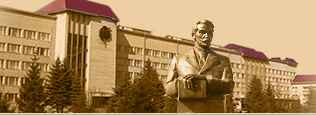ANTHROPOGENIC CHANGES OF ECOSYSTEMS OF THE DJURIN RIVER BASIN TO HOUSEHOLD ACTIVITY.
Anthropogenic or anthropic transformation of geosystems occurs as a result of the impact on them of different types of economic activity: emissions of pollutants into the environment, plowing and processing of farmland, reclamation of wetlands, deforestation, mining, storage of industrial and solid household waste, and the like. It reflects the nature of changes and transformations of system-forming processes (hydrologic cycle, energy transformation, nutrient turnover and abiogenic migration of substances), as well as the degree of degradation of geocomponents and the geosystem as a whole. The problem of anthropogenic transformation of the ecological and geographical processes that have arisen within the agroecosystems, meliorative and contaminated land areas of the river basin of Djurin is considered. The functional-territorial analysis of the land areas of the river basin was carried out for the peculiarities of the transformation processes: – dangerous ecological changes with violation of the water balance of the territory within the watershed areas; – Areas of intensification of water-erosion processes prevalent within slope areas; – Areas of radiation and chemically contaminated areas associated with soil depletion and the accumulation of residual products of the decay of radionuclides, pesticides, nitrates of other toxic elements and compounds. Areas of their overlap are identified and environmental risks are determined for the soil-vegetation cover, surface and surface and groundwater, and the ecosystem as a whole. Assessing the level of the ecological state of the ecosystem of the Djurin basin, we consider it to be an ancestral one, because changes in the water balance of the territory, depletion, dehumification of the soils and the accumulation in them of the residual products of the decay of radionuclides, pesticides, nitrates of other toxic elements and compounds can become irreversible and become more difficult for the future.
Key words: anthropogenic changes, river basin, optimization of nature management.
References:
- Balatskyy O.F. Antolohyya эkonomyky chystoy sredы. / O.F. Balatskyy – Sumы: YTD „Unyversytet·skaya knyha”, 2007. – 272 s.
- Hofman K.Kh. Sotsyal’no-эkonomycheskye aspektы razrabotky rehyonal’nыkh prohramm pryrodopol’zovanyya / K.Kh. Hofman // Sotsyalyzm y pryroda. – M.: Mыsl’, 1982. – S. 93-120.
- Hrodzyns’kyy M.D. Piznannya landshaftu: mistse i prostir. [Monohrafiya u 2-kh t.] / M.D. Hrodzyns’kyy – K.: Vydavnycho-polihrafichnyy tsentr „Kyyivs’kyy Universytet”: T.1. – 2005. – 431 s. T.2. – 2005. – 503 s.
- Kovalyshyn D.I. Kontaktno-luhovi chornozemy Zakhidnoho Podillya ta yikh mistse v klasyfikatsiyi /D.I.Kovalyshyn, S.V.Hulyk // Kozlovs’kyy B. I. Melioratyvnyy stan osushuval’nykh zemel’ zakhidnykh oblastey Ukrayiny / B. I. Kozlovs’kyy. – L’viv : Yevrosvit, 2005. – 420 s.
- Pryrodno-resursnyy aspekt rozvytku Ukrayiny / Proekt „Prohrama spryyannya stalomu rozvytku v Ukrayini”, ker. rozd. I.D. Andriyevs’kyy, Yu.R. Shelyah-Sosonko. – Kyyiv: “KM Academia”, 2001. – 112 s.
- Tsaryk L.P. Ekoloho-heohrafichnyy analiz i otsinyuvannya terytoriyi: teoriya ta praktyka / L.P. Tsaryk. – Ternopil’: „Navchal’na knyha – Bohdan”, 2006. – 256 s.
- Shyshchenko P.H. Prykladnaya fyzycheskaya heohrafyya / P.H. Shyshchenko. – K.: Vyshcha shkola, 1988. – 192 s.
- Shyshchenko P.H. Prykladni ekoloho-heohrafichni doslidzhennya: ob”yektno-predmetna sutnist’, polya zastosuvannya / P.H. Shyshchenko // Ekoloho-heohrafichni doslidzhennya v suchasniy heohrafichniy nautsi. – Ternopil’: Vydavn. viddil TDPU, 1999. – S. 3-4.
Full text:
